JEE MAIN (AIEEE) Past Exam Paper-2008
Mathematics
PART-A
1. AB is a vertical pole with B at the ground level and A at the top. A man finds that the angle of elevation of the point A from a certain point C on the ground is 60°. He moves away from the pole along the line BC to a point D such that CD = 7 m. From D the angle of elevation of the point A is 45°. Then the height of the pole is
(1) ![]()
(2) ![]()
(3) ![]()
(4) ![]()
2. It is given that the events A and B are such that
![]()
Then P(B) is
(1) 1/6
(2) 1/3
(3) 2/3
(4) 1/2
3. A die is thrown. Let A be the event that the number obtained is greater than 3. Let B be the event that the number obtained is less than 5. Then P (A ∪ B) is
(1) 3/5
(2) 0
(3) 1
(4) 2/5
4. A focus of an ellipse is at the origin. The directrix is the line x = 4 and the eccentricity is 1/2. Then the length of the semi−major axis is
(1) 8/3
(2) 2/3
(3) 4/3
(4) 5/3
5. A parabola has the origin as its focus and the line x = 2 as the directrix. Then the vertex of the parabola is at
(1) (0, 2)
(2) (1, 0)
(3) (0, 1)
(4) (2, 0)
6. The point diametrically opposite to the point P (1, 0) on the circle x2 + y2 + 2x + 4y − 3 = 0 is
(1) (3, −4)
(2) (−3, 4)
(3) (−3, −4)
(4) (3, 4)
7. Let f : N → Y be a function defined as f (x) = 4x + 3, where Y = {y ∈ N : y = 4x + 3 for some x ∈ N}. Show that f is invertible and its inverse is
(1) ![]()
(2) ![]()
(3) ![]()
(4) ![]()
8. The conjugate of a complex number is ![]() Then the complex number is
Then the complex number is
(1) ![]()
(2) ![]()
(3) ![]()
(4) ![]()
9. Let R be the real line. Consider the following subsets of the plane R × R.
S = {(x, y) : y = x + 1 and 0 < x < 2}, T = {(x, y) : x − y is an integer}. Which one of the following is true?
(1) neither S nor T is an equivalence relation on R
(2) both S and T are equivalence relations on R
(3) S is an equivalence relation on R but T is not
(4) T is an equivalence relation on R but S is not
10. The perpendicular bisector of the line segment joining P (1, 4) and Q (k, 3) has y−intercept − 4. Then a possible value of k is
(1) 1
(2) 2
(3) −2
(4) −4
11. The solution of the differential equation ![]() satisfying the condition y(1) = 1 is
satisfying the condition y(1) = 1 is
(1) y = ln x + x
(2) y = x ln x + x2
(3) y = xe(x – 1)
(4) y = x ln x + x
12. The mean of the numbers a, b, 8, 5, 10 is 6 and the variance is 6.80. Then which one of the following gives possible values of a and b?
(1) a = 0, b =7
(2) a = 5, b = 2
(3) a = 1, b = 6
(4) a = 3, b = 4
13. The vector ![]() lies in the plane of the vectors
lies in the plane of the vectors ![]() and bisects the angle between
and bisects the angle between ![]() Then which one of the following possible values of α and β?
Then which one of the following possible values of α and β?
(1) α = 2, β = 2
(2) α = 1, β = 2
(3) α = 2, β = 1
(4) α = 1, β = 1
14. The non-zero vectors ![]() are related by
are related by ![]() Then the angle between
Then the angle between ![]() is
is
(1) 0
(2) π/4
(3) π/2
(4) π
15. The line passing through the points (5, 1, a) and (3, b, 1) crosses the yz−plane at the point ![]() Then
Then
(1) a = 2, b= 8
(2) a = 4, b = 6
(3) a = 6, b = 4
(4) a = 8, b = 2
16. If the straight lines ![]() and
and ![]() intersect at a point, then the integer k is equal to
intersect at a point, then the integer k is equal to
(1) −5
(2) 5
(3) 2
(4) −2
Directions: Questions number 17 to 21 are Assertion−Reason type questions. Each of these questions contains two statements : Statement − 1 (Assertion) and Statement−2 (Reason). Each of these questions also has four alternative choices, only one of which is the correct answer. You have to select the correct choice.
17. Statement -1 : For every natural number n ≥ 2, ![]()
Statement-2 : For every natural number n ≥ 2, ![]()
(1) Statement −1 is false, Statement −2 is true
(2) Statement −1 is true, Statement −2 is true, Statement −2 is a correct explanation for Statement −1
(3) Statement −1 is true, Statement −2 is true; Statement −2 is not a correct explanation for Statement −1.
(4) Statement − 1 is true, Statement − 2 is false.
18. Let A be a 2 × 2 matrix with real entries. Let I be the 2 × 2 identity matrix. Denote by tr (A), the sum of diagonal entries of A. Assume that A2 = I.
Statement −1: If A ≠ I and A ≠ − I, then det A = − 1.
Statement −2: If A ≠ I and A ≠ − I, then tr (A) ≠ 0.
(1) Statement −1 is false, Statement −2 is true
(2) Statement −1 is true, Statement −2 is true, Statement −2 is a correct explanation for Statement −1
(3) Statement −1 is true, Statement −2 is true; Statement −2 is not a correct explanation for Statement −1.
(4) Statement − 1 is true, Statement − 2 is false.
19. Statement – 1: 
Statement – 2: 
(1) Statement −1 is false, Statement −2 is true
(2) Statement −1 is true, Statement −2 is true, Statement −2 is a correct explanation for Statement −1
(3) Statement −1 is true, Statement −2 is true; Statement −2 is not a correct explanation for Statement −1.
(4) Statement − 1 is true, Statement − 2 is false.
20. Let p be the statement “x is an irrational number”, q be the statement “y is a transcendental number”, and r be the statement “x is a rational number iff y is a transcendental number”.
Statement –1: r is equivalent to either q or p
Statement –2: r is equivalent to ∼ (p ↔ ∼ q).
(1) Statement −1 is false, Statement −2 is true
(2) Statement −1 is true, Statement −2 is true, Statement −2 is a correct explanation for Statement −1
(3) Statement −1 is true, Statement −2 is true; Statement −2 is not a correct explanation for Statement −1.
(4) Statement − 1 is true, Statement − 2 is false.
21. In a shop there are five types of ice-creams available. A child buys six ice-creams.
Statement -1: The number of different ways the child can buy the six ice-creams is 10C5.
Statement -2: The number of different ways the child can buy the six ice-creams is equal to the number of different ways of arranging 6 A’s and 4 B’s in a row.
(1) Statement −1 is false, Statement −2 is true
(2) Statement −1 is true, Statement −2 is true, Statement −2 is a correct explanation for Statement −1
(3) Statement −1 is true, Statement −2 is true; Statement −2 is not a correct explanation for Statement −1.
(4) Statement − 1 is true, Statement − 2 is false.
22. Let  Then which one of the following is true?
Then which one of the following is true?
(1) f is neither differentiable at x = 0 nor at x = 1
(2) f is differentiable at x = 0 and at x = 1
(3) f is differentiable at x = 0 but not at x = 1
(4) f is differentiable at x = 1 but not at x = 0
23. The first two terms of a geometric progression add up to 12. The sum of the third and the fourth terms is 48. If the terms of the geometric progression are alternately positive and negative, then the first term is
(1) −4
(2) −12
(3) 12
(4) 4
24. Suppose the cube x3 – px + q has three distinct real roots where p > 0 and q > 0. Then which one of the following holds?
(1) The cubic has minima at ![]() and maxima at
and maxima at ![]()
(2) The cubic has minima at ![]() and maxima at
and maxima at![]()
(3) The cubic has minima at both ![]() and
and![]()
(4) The cubic has maxima at both ![]() and
and ![]()
25. How many real solutions does the equation x7 + 14x5 + 16x3 + 30x – 560 = 0 have?
(1) 7
(2) 1
(3) 3
(4) 5
26. The statement p → (q → p) is equivalent to
(1) p → (p → q)
(2) p → (p ∨ q)
(3) p → (p ∧ q)
(4) p → (p ↔ q)
27. The value of  is
is
(1) 6/17
(2) 3/17
(3) 4/17
(4) 5/17
28. The differential equation of the family of circles with fixed radius 5 units and centre on the line y = 2 is
(1) (x – 2)y′2 = 25 – (y – 2)2
(2) (y – 2)y′2 = 25 – (y – 2)2
(3) (y – 2)2y′2 = 25 – (y – 2)2
(4) (x – 2)2y′2 = 25 – (y – 2)2
29. Let  Then which one of the following is true?
Then which one of the following is true?
(1) ![]()
(2) ![]()
(3) ![]()
(4) ![]()
30. The area of the plane region bounded by the curves x + 2y2 = 0 and x + 3y2 = 1 is equal to
(1) 5/3
(2) 1/3
(3) 2/3
(4) 4/3
31. The value of  is
is
(1) 
(2) 
(3) 
(4) 
32. How many different words can be formed by jumbling the letters in the word MISSISSIPPI in which no two S are adjacent?
(1) 8 . 6C4 . 7C4
(2) 6 . 7 . 8C4
(3) 6 . 8 . 7C4
(4) 7 . 6C4 . 8C4
33. Let a, b, c be any real numbers. Suppose that there are real numbers x, y, z not all zero such that x = cy + bz, y = az + cx and z = bx + ay. Then a2 + b2 + c2 + 2abc is equal to
(1) 2
(2) −1
(3) 0
(4) 1
34. Let A be a square matrix all of whose entries are integers. Then which one of the following is true?
(1) If detA = ± 1, then A–1 exists but all its entries are not necessarily integers
(2) If detA ≠ ± 1, then A–1 exists and all its entries are non-integers
(3) If detA = ± 1, then A–1 exists and all its entries are integers
(4) If detA = ± 1, then A–1 need not exist
35. The quadratic equations x2 – 6x + a = 0 and x2 – cx + 6 = 0 have one root in common. The other roots of the first and second equations are integers in the ratio 4 : 3. Then the common root is
(1) 1
(2) 4
(3) 3
(4) 2
Chemistry
PART – B
36. The organic chloro compound, which shows complete stereochemical inversion during a SN2 reaction, is
(1) (C2H5)2CHCl
(2) (CH3)3CCl
(3) (CH3)2CHCl
(4) CH3Cl
37. Toluene is nitrated and the resulting product is reduced with tin and hydrochloric acid. The product so obtained is diazotised and then heated with cuprous bromide. The reaction mixture so formed contains
(1) mixture of o− and p−bromotoluenes
(2) mixture of o− and p−dibromobenzenes
(3) mixture of o− and p−bromoanilines
(4) mixture of o− and m−bromotoluenes
38. The coordination number and the oxidation state of the element ‘E’ in the complex [E(en)2(C2O4)]NO2 (where (en) is ethylene diamine) are, respectively,
(1) 6 and 2
(2) 4 and 2
(3) 4 and 3
(4) 6 and 3
39. Identify the wrong statements in the following:
(1) Chlorofluorocarbons are responsible for ozone layer depletion
(2) Greenhouse effect is responsible for global warming
(3) Ozone layer does not permit infrared radiation from the sun to reach the earth
(4) Acid rains is mostly because of oxides of nitrogen and sulphur
40. Phenol, when it first reacts with concentrated sulphuric acid and then with concentrated nitric acid, gives
(1) 2,4,6-trinitrobenzene
(2) o-nitrophenol
(3) p-nitrophenol
(4) nitrobenzene
41. In the following sequence of reactions, the alkene affords the compound ‘B’
![]()
The compound B is
(1) ![]()
(2) ![]()
(3) ![]()
(4) ![]()
42. Larger number of oxidation states are exhibited by the actinoids than those by the lanthanoids, the main reason being
(1) 4f orbitals more diffused than the 5f orbitals
(2) lesser energy difference between 5f and 6d than between 4f and 5d orbitals
(3) more energy difference between 5f and 6d than between 4f and 5d orbitals
(4) more reactive nature of the actinoids than the lanthanoids
43. In which of the following octahedral complexes of Co (at. no. 27), will the magnitude of Δo be the highest?
(1) [Co(CN)6]3−
(2) [Co(C2O4)3]3−
(3) [Co(H2O)6]3+
(4) [Co(NH3)6]3+
44. At 80°C, the vapour pressure of pure liquid ‘A’ is 520 mm Hg and that of pure liquid ‘B’ is 1000 mm Hg. If a mixture solution of ‘A’ and ‘B’ boils at 80°C and 1 atm pressure, the amount of ‘A’ in the mixture is (1 atm = 760 mm Hg)
(1) 52 mol percent
(2) 31 mol percent
(3) 48 mol percent
(4) 50 mol percent
45. For a reaction ![]() rate of disappearance of ‘A’ is related to the rate of appearance of ‘B’ by the expression
rate of disappearance of ‘A’ is related to the rate of appearance of ‘B’ by the expression
(1) ![]()
(2) ![]()
(3) ![]()
(4) ![]()
46. The equilibrium constants ![]() for the reactions X⇌ 2Y and Z ⇌ P +Q, respectively are in the ratio of 1 : 9. If the degree of dissociation of X and Z be equal then the ratio of total pressure at these equilibria is
for the reactions X⇌ 2Y and Z ⇌ P +Q, respectively are in the ratio of 1 : 9. If the degree of dissociation of X and Z be equal then the ratio of total pressure at these equilibria is
(1) 1 : 36
(2) 1 : 1
(3) 1 : 3
(4) 1 : 9
47. Oxidising power of chlorine in aqueous solution can be determined by the parameters indicated below:

![]()
The energy involved in the conversion of ![]()
(using the data, ![]()
![]()
![]()
(1) +152 kJmol−1
(2) −610 kJmol−1
(3) −850 kJmol−1
(4) +120 kJmol−1
48. Which of the following factors is of no significance for roasting sulphide ores to the oxides and not subjecting the sulphide ores to carbon reduction directly?
(1) Metal sulphides are thermodynamically more stable than CS2
(2) CO2 is thermodynamically more stable than CS2
(3) Metal sulphides are less stable than the corresponding oxides
(4) CO2 is more volatile than CS2
49. Bakelite is obtained from phenol by reacting with
(1) (CH2OH)2
(2) CH3CHO
(3) CH3COCH3
(4) HCHO
50. For the following three reactions a, b and c, equilibrium constants are given:
(a) CO(g) + H2O(g) ⇋ CO2(g) + H2(g); K1
(b) CH4(g) + H2O(g) ⇌ CO (g) + 3H2(g); K2
(c) CH4(g) + 2H2O(g) ⇌ CO2(g) + 4H2(g); K3
Which of the following relations is correct?
(1) ![]()
(2) K2K3 = K1
(3) K3 = K1K2
(4) K3K23 = K12
51. The absolute configuration of

is
(1) S, S
(2) R, R
(3) R, S
(4) S, R
52. The electrophile, E⊕ attacks the benzene ring to generate the intermediate σ-complex. Of the following, which σ-complex is of lowest energy?
(1) 
(2) 
(3) 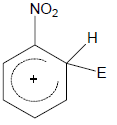
(4) 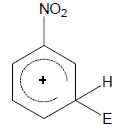
53. α-D-(+)-glucose and β-D-(+)-glucose are
(1) conformers
(2) epimers
(3) anomers
(4) enantiomers
54. Standard entropy of X2, Y2 and XY3 are 60, 40 and 50 JK−1 mol−1, respectively. For the reaction, ![]() ∆H = −30 kJ, to be at equilibrium, the temperature will be
∆H = −30 kJ, to be at equilibrium, the temperature will be
(1) 1250 K
(2) 500 K
(3) 750 K
(4) 1000 K
55. Four species are listed below

Which one of the following is the correct sequence is their acid strength?
(1) iv < ii < iii < i
(2) ii < iii < i < iv
(3) i < iii < ii < iv
(4) iii < i < iv < ii
56. Which one of the following constitutes a group of the isoelectronic species?
(1) ![]()
(2) ![]()
(3) ![]()
(4) ![]()
57. Which one of the following pairs of species have the same bond order?
(1) CN− and NO+
(2) CN− and CN+
(3) ![]()
(4) NO+ and CN+
58. The ionization enthalpy of hydrogen atom is 1.312 × 106 Jmol−1. The energy required to excite the electron in the atom from n = 1 to n = 2 is
(1) 8.51 × 105 Jmol−1
(2) 6.56 × 105 Jmol−1
(3) 7.56 × 105 Jmol−1
(4) 9.84 × 105 Jmol−1
59. Which one of the following is the correct statement?
(1) Boric acid is a protonic acid
(2) Beryllium exhibits coordination number of six
(3) Chlorides of both beryllium and aluminium have bridged chloride structures in solid phase
(4) B2H6 . 2NH3 is known as ‘inorganic benzene’
60. Given ![]() The potential for the cell Cr | Cr3+ (0.1 M)| | Fe2+(0.01 M)| Fe is
The potential for the cell Cr | Cr3+ (0.1 M)| | Fe2+(0.01 M)| Fe is
(1) 0.26 V
(2) 0.399 V
(3) −0.339 V
(4) −0.26 V
61. Amount of oxalic acid present in a solution can be determined by its titration with KMnO4 solution in the presence of H2SO4. The titration gives unsatisfactory result when carried out in the presence of HCl, because HCl
(1) gets oxidised by oxalic acid to chlorine
(2) furnishes H+ ions in addition to those from oxalic acid
(3) reduces permanganate to Mn2+
(4) oxidises oxalic acid to carbon dioxide and water
62. The vapour pressure of water at 20°C is 17.5 mm Hg. If 18 g of glucose (C6H12O6) is added to 178.2 g of water at 20°C, the vapour pressure of the resulting solution will be
(1) 17.675 mm Hg
(2) 15.750 mm Hg
(3) 16.500 mm Hg
(4) 17.325 mm Hg
63. Among the following substituted silanes the one which will give rise to cross linked silicone polymer on hydrolysis is
(1) R4Si
(2) RSiCl3
(3) R2SiCl2
(4) R3SiCl
64. In context with the industrial preparation of hydrogen from water gas (CO + H2), which of the following is the correct statement?
(1) CO and H2 are fractionally separated using differences in their densities
(2) CO is removed by absorption in aqueous Cu2Cl2 solution
(3) H2 is removed through occlusion with Pd
(4) CO is oxidized to CO2 with steam in the presence of a catalyst followed by absorption of CO2 in alkali
65. In a compound atoms of element Y from ccp lattice and those of element X occupy 2/3rd of tetrahedral voids. The formula of the compound will be
(1) X4Y3
(2) X2Y3
(3) X2Y
(4) X3Y4
66. Gold numbers of protective colloids A, B, C and D are 0.50, 0.01, 0.10 and 0.005, respectively. The correct order of their protective powers is
(1) D < A < C < B
(2) C < B < D < A
(3) A < C < B < D
(4) B < D < A < C
67. The hydrocarbon which can react with sodium in liquid ammonia is
(1) CH3CH2CH2C ≡ CCH2CH2CH3
(2) CH3CH2C ≡ CH
(3) CH3CH = CHCH3
(4) CH3CH2C ≡ CCH2CH3
68. The treatment of CH3MgX with CH3C≡C−H produces
(1) CH3 – CH = CH2
(2) CH3C ≡ C – CH3
(3) 
(4) CH4
69. The correct decreasing order of priority for the functional groups of organic compounds in the IUPAC system of nomenclature is
(1) −COOH, −SO3H, −CONH2, −CHO
(2) −SO3H, −COOH, −CONH2, −CHO
(3) −CHO, −COOH, −SO3H, −CONH2
(4) −CONH2, −CHO, −SO3H, −COOH
70. The pKa of a weak acid, HA, is 4.80. The pKb of a weak base, BOH, is 4.78. The pH of an aqueous solution of the corresponding salt, BA, will be
(1) 9.58
(2) 4.79
(3) 7.01
(4) 9.22
Physics
PART – C
Directions: Questions No. 71, 72 and 73 are based on the following paragraph.
Wave property of electrons implies that they will show diffraction effects. Davisson and Germer demonstrated this by diffracting electrons from crystals. The law governing the diffraction from a crystal is obtained by
requiring that electron waves reflected from the planes of atoms in a crystal interfere constructively (see in figure).

71. Electrons accelerated by potential V are diffracted from a crystal. If d = 1Å and i = 30°, V should be about (h = 6.6 × 10−34 Js, me = 9.1 × 10−31 kg, e = 1.6 × 10−19 C)
(1) 2000 V
(2) 50 V
(3) 500 V
(4) 1000 V
72. If a strong diffraction peak is observed when electrons are incident at an angle ‘i’ from the normal to the crystal planes with distance ‘d’ between them (see figure), de Broglie wavelength λdB of electrons can be calculated by the relationship (n is an integer)
(1) d sin i = nλdB
(2) 2d cos i = nλdB
(3) 2d sin i = nλdB
(4) d cos i = nλdB
73. In an experiment, electrons are made to pass through a narrow slit of width ‘d’ comparable to their de Broglie wavelength. They are detected on a screen at a distance ‘D’ from the slit (see figure).
Which of the following graph can be expected to represent the number of electrons ‘N’ detected as a function of the detector position ‘y’(y = 0 corresponds to the middle of the slit)?
(1) 
(2) 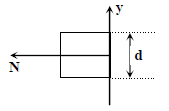
(3) 
(4) 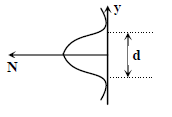
74. A planet in a distant solar system is 10 times more massive than the earth and its radius is 10 times smaller. Given that the escape velocity from the earth is 11 kms−1, the escape velocity from the surface of the planet would be
(1) 1.1 kms−1
(2) 11 kms−1
(3) 110 kms−1
(4) 0.11 kms−1
75. A spherical solid ball of volume V is made of a material of density ρ1. It is falling through a liquid of density ρ2(ρ2 <ρ1). Assume that the liquid applies a viscous force on the ball that is proportional to the square of its speed v, i.e. Fviscous = −kv2(k > 0). The terminal speed of the ball is
(1) 
(2) ![]()
(3) 
(4) ![]()
76. Shown in the figure below is a meter-bridge set up with null deflection in the galvanometer.

The value of the unknown resistor R is
(1) 13.75 Ω
(2) 220 Ω
(3) 110 Ω
(4) 55 Ω
77. A thin rod of length ‘L’ is lying along the x-axis with its ends at x = 0 and x = L. Its linear density (mass/length) varies with x as k(x/L)n, where n can be zero or any positive number. If the position xCM of the centre of mass of the rod is plotted against ‘n’, which of the following graphs best approximates the dependence of xCM on n?
(1) 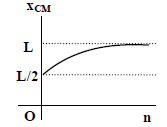
(2) 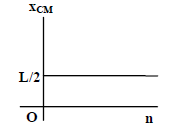
(3) 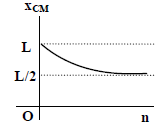
(4) 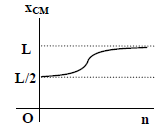
78. While measuring the speed of sound by performing a resonance column experiment, a student gets the first resonance condition at a column length of 18 cm during winter. Repeating the same experiment during summer, she measures the column length to be x cm for the second resonance. Then
(1) 18 > x
(2) x > 54
(3) 54 > x > 36
(4) 36 > x > 18
79. The dimension of magnetic field in M, L, ,T and C (Coulomb) is given as
(1) MLT−1C−1
(2) MT2C−2
(3) MT−1C−1
(4) MT−2C−1
80. Consider a uniform square plate of side ‘a’ and mass ‘m’. The moment of inertia of this plate about an axis perpendicular to its plane and passing through one of its corners is
(1) ![]()
(2) ![]()
(3) ![]()
(4) ![]()
81. A body of mass m = 3.513 kg is moving along the x-axis with a speed of 5.00 ms−1. The magnitude of its momentum is recorded as
(1) 17.6 kg ms−1
(2) 17.565 kg ms−1
(3) 17.56 kg ms−1
(4) 17.57 kg ms−1
82. An athlete in the olympic games covers a distance of 100 m in 10 s. His kinetic energy can be estimated to be in the range
(1) 200 J − 500 J
(2) 2 × 105 J − 3 × 105 J
(3) 20,000 J – 50,000 J
(4) 2,000 J – 5,000 J
83. A parallel plate capacitor with air between the plates has a capacitance of 9 pF. The separation between its plates is ‘d’. The space between the plates is now filled with two dielectrics. One of the dielectrics has dielectric constant k1 = 3 and thickness d/3 while the other one has dielectric constant k2 = 6 and thickness 2d/3. Capacitance of the capacitor is now
(1) 1.8 pF
(2) 45 pF
(3) 40.5 pF
(4) 20.25 pF
84. The speed of sound in oxygen (O2) at a certain temperature is 460 ms−1. The speed of sound in helium (He) at the same temperature will be (assumed both gases to be ideal)
(1) 460 ms−1
(2) 500 ms−1
(3) 650 ms−1
(4) 330 ms−1
85. This question contains Statement -1 and Statement-2. Of the four choices given after the statements, choose the one that best describes the two statements.
Statement – I:
Energy is released when heavy nuclei undergo fission or light nuclei undergo fusion.
and
Statement – II
For heavy nuclei, binding energy per nucleon increases with increasing Z while for light nuclei it decrease with increasing Z.
(1) Statement – 1is false, Statement – 2 is true.
(2) Statement – 1is true, Statement – 2 is true; Statement -2 is correct explanation for Statement-1.
(3) Statement – 1is true, Statement – 2 is true; Statement -2 is not a correct explanation for Statement-1.
(4) Statement – 1 is true, Statement – 2 is False.
86. This question contains Statement -1 and Statement-2. Of the four choices given after the statements, choose the one that best describes the two statements.
Statement – I:
For a mass M kept at the centre of a cube of side ‘a’, the flux of gravitational field passing through its sides is 4π GM.
and
Statement – II
If the direction of a field due to a point source is radial and its dependence on the distance ‘r’ for the source is given as 1/r2, its flux through a closed surface depends only on the strength of the source enclosed by the surface and not on the size or shape of the surface
(1) Statement – 1is false, Statement – 2 is true.
(2) Statement – 1is true, Statement – 2 is true; Statement -2 is correct explanation for Statement-1.
(3) Statement – 1is true, Statement – 2 is true; Statement -2 is not a correct explanation for Statement-1.
(4) Statement – 1 is true, Statement – 2 is False.
87. A jar filled with two non mixing liquids 1 and 2 having densities ρ1 and ρ2 A solid ball, made of a material of density ρ3, is dropped in the jar. It comes to equilibrium in the position shown in the figure.
Which of the following is true for ρ1, ρ2 and ρ3?

(1) ρ3 < ρ1 < ρ2
(2) ρ1 < ρ3 < ρ2
(3) ρ1 < ρ2 < ρ3
(4) ρ1 < ρ3 < ρ2
88. A working transistor with its three legs marked P, Q and R is tested using a multimeter. No conduction is found between P and Q. By connecting the common (negative) terminal of the multimeter to R and the other (positive) terminal to P or Q, some resistance is seen on the multimeter. Which of the following is true for the transistor?
(1) It is an npn transistor with R as base
(2) It is a pnp transistor with R as collector
(3) It is a pnp transistor with R as emitter
(4) It is an npn transistor with R as collector
Directions: Question No. 89 and 90 are based on the following paragraph.
Consider a block of conducting material of resistivity ‘ρ’ shown in the figure. Current ‘I’ enters at ‘A’ and leaves from ‘D’. We apply superposition principle to find voltage ‘ΔV’ developed between ‘B’ and ‘C’. The calculation is done in the following steps:
(i) Take current ‘I’ entering from ‘A’ and assume it to spread over a hemispherical surface in the block.
(ii) Calculate field E(r) at distance ‘r’ from A by using Ohm’s law E = ρj, where j is the current per unit area at ‘r’.
(iii) From the ‘r’ dependence of E(r), obtain the potential V(r) at r.
(iv) Repeat (i), (ii) and (iii) for current ‘I’ leaving ‘D’ and superpose results for ‘A’ and ‘D’.
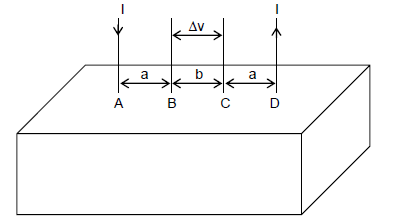
89. ∆V measured between B and C is
(1) 
(2) ![]()
(3) ![]()
(4) ![]()
90. For current entering at A, the electric field at a distance ‘r’ from A is
(1) ![]()
(2) ![]()
(3) ![]()
(4) ![]()
91. A student measures the focal length of convex lens by putting an object pin at a distance ‘u’ from the lens and measuring the distance ‘v’ of the image pin. The graph between ‘u’ and ‘v’ plotted by the student should look like
(1) 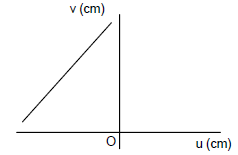
(2) 
(3) 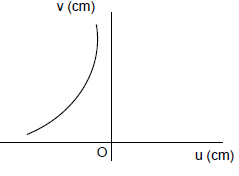
(4) 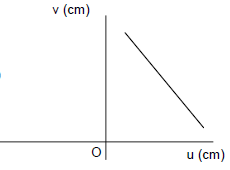
92. A block of mass 0.50 kg is moving with a speed of 2.00 m/s on a smooth surface. It strikes another mass of 1.00 kg and then they move together as a single body. The energy loss during the collision is
(1) 0.16 J
(2) 1.00 J
(3) 0.67 J
(4) 0.34 J
93. A capillary tube (A) is dropped in water. Another identical tube (B) is dipped in a soap water solution. Which of the following shows the relative nature of the liquid columns in the two tubes?
(1) 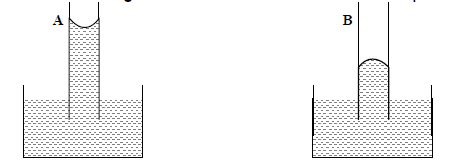
(2) 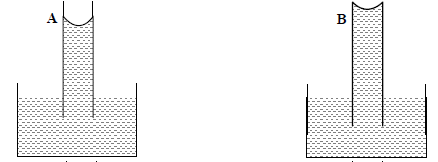
(3) 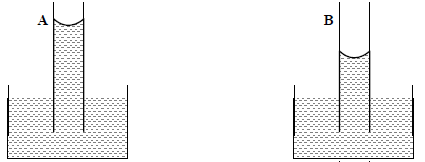
(4) 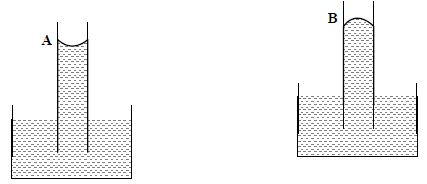
94. Suppose an electron is attracted towards the origin by a force k/r where ‘k’ is a constant and ‘r’ is the distance of the electron from the origin. By applying Bohr model to this system, the radius of the nth orbital of the electron is found to be ‘rn’ and the kinetic energy of the electron to be Tn. Then which of the following is true?
(1) Tn ∝ 1/n2, rn ∝ n2
(2) Tn independent of n, rn ∝ n
(3) Tn ∝ 1/n, rn ∝ n
(4) Tn ∝ 1/n, rn ∝ n2
95. A wave travelling along the x-axis is described by the equation y(x, t) = 0.005 cos (αx −βt). If the wavelength and the time period of the wave are 0.08 m and 2.0 s, respectively, then α and β in appropriate units are
(1) α = 25.00 π, β = π
(2) ![]()
(3) ![]()
(4) α = 12.50 π, β = π/2.0
96. Two coaxial solenoids are made by winding thin insulated wire over a pipe of cross sectional area A = 10 cm2 and length = 20 cm. If one of the solenoids has 300 turns and the other 400 turns, their mutual inductance is (μ0 = 4π × 10−7 Tm A−1)
(1) 2.4 π × 10−5 H
(2) 4.8 π × 10−4 H
(3) 4.8 π × 10−5 H
(4) 2.4 π × 10−4 H
97. In the circuit below, A and B represent two inputs and C represents the output.

The circuit represents
(1) NOR gate
(2) AND gate
(3) NAND gate
(4) OR gate
98. A body is at rest at x = 0. At t = 0, it starts moving in the positive x-direction with a constant acceleration. At the same instant another body passes through x = 0 moving in the positive x-direction with a constant speed. The position of the first body is given by x1(t) after time ‘t’ and that of the second body by x2(t) after the same time interval. Which of the following graphs correctly describes (x1 – x2)as a function of time ‘t’?
(1) 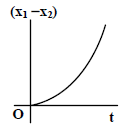
(2) 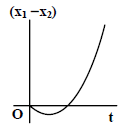
(3) 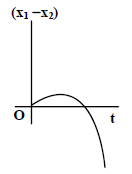
(4) 
99. An experiment is performed to find the refractive index of glass using a travelling microscope. In this experiment distance are measured by
(1) a vernier scale provided on the microscope
(2) a standard laboratory scale
(3) a meter scale provided on the microscope
(4) a screw gauage provided on the microscope
100. A thin spherical shell of radius R has charge Q spread uniformly over its surface. Which of the following graphs most closely represents the electric field E(r) produced by the shell in the range 0 ≤ r < ∞ , where r is the distance from the centre of the shell?
(1) 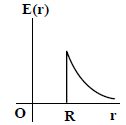
(2) 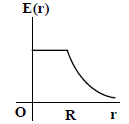
(3) 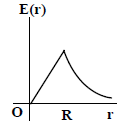
(4) 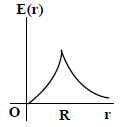
101. A 5V battery with internal resistance 2Ω and a 2V battery with internal resistance 1Ω are connected to a 10Ω resistor as shown in the figure. The current in the 10 Ω resistor is

(1) 0.27 A P2 to P1
(2) 0.03 A P1 to P2
(3) 0.03 A P2 to P1
(4) 0.27 A P1 to P2
102. A horizontal overhead power line is at a height of 4m from the ground and carries a current of 100 A from east to west. The magnetic field directly below it on the ground is (μ0 = 4π × 10−7T m A−1)
(1) 2.5 × 10−7 T southward
(2) 5 × 10−6 T northward
(3) 5 × 10−6 T southward
(4) 2.5 × 10−7 T northward
103. Relative permittivity and permeability of a material are εr and μr, respectively. Which of the following values of these quantities are allowed for a diamagnetic material?
(1) εr = 0.5, μr = 1.5
(2) εr = 1.5, μr = 0.5
(3) εr = 0.5, μr = 0.5
(4) εr = 1.5, μr = 1.5
104. Two full turns of the circular scale of a screw gauge cover a distance of 1 mm on its main scale. The total number of divisions on the circular scale is 50. Further, it is found that the screw gauge has a zero error of − 0.03 mm while measuring the diameter of a thin wire, a student notes the main scale reading of 3 mm and the number of circular scale divisions in line with the main scale as 35. The diameter of the wire is
(1) 3.32 mm
(2) 3.73 mm
(3) 3.67 mm
(4) 3.38 mm
105. An insulated container of gas has two chambers separated by an insulating partition. One of the chambers has volume V1 and contains ideal gas at pressure P1 and temperature T1. The other chamber has volume V2 and contains ideal gas at pressure P2 and temperature T2. If the partition is removed without doing any work on the gas, the final equilibrium temperature of the gas in the container will be
(1) 
(2) 
(3) 
(4) 
Latest Govt Job & Exam Updates: